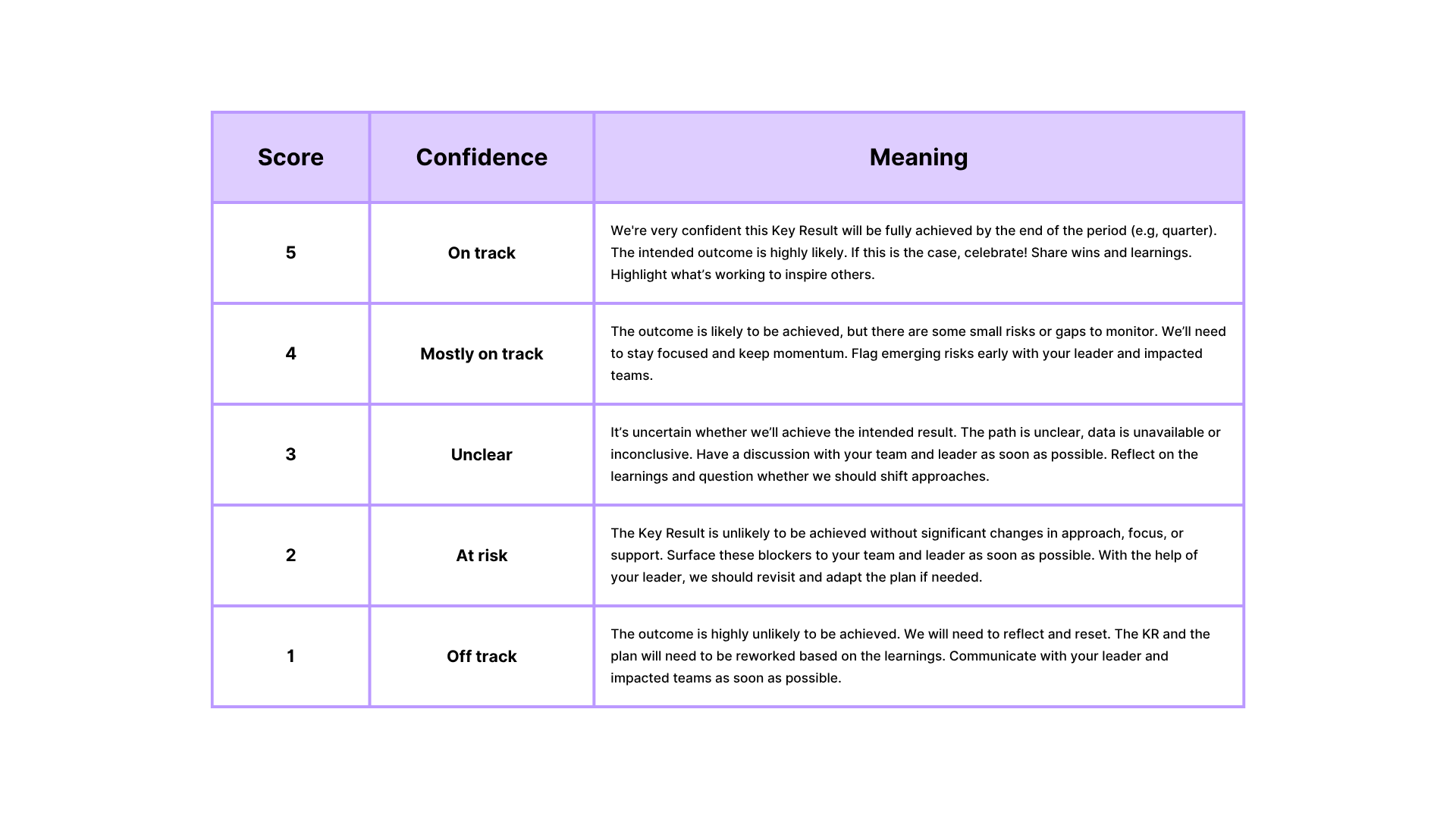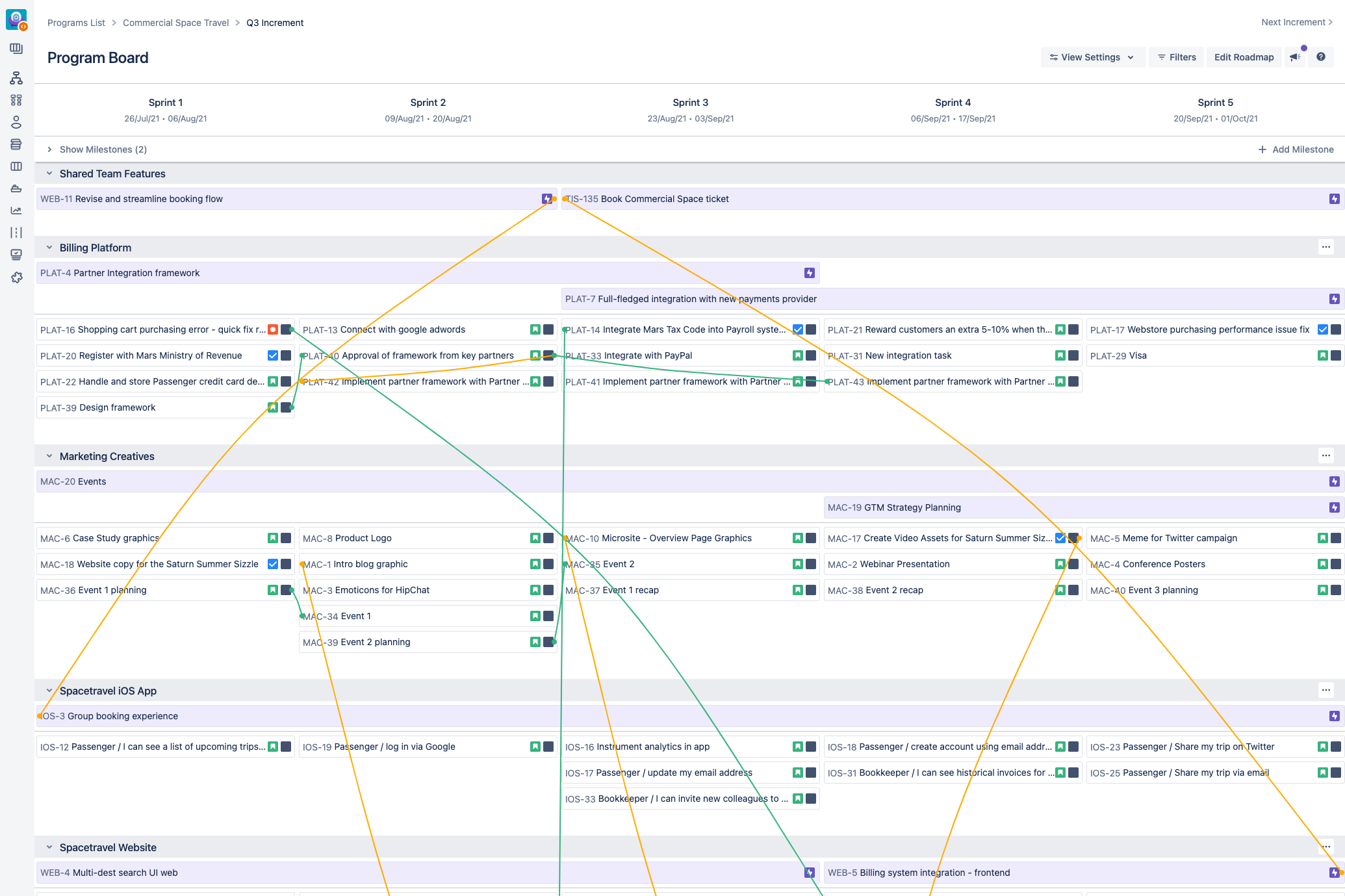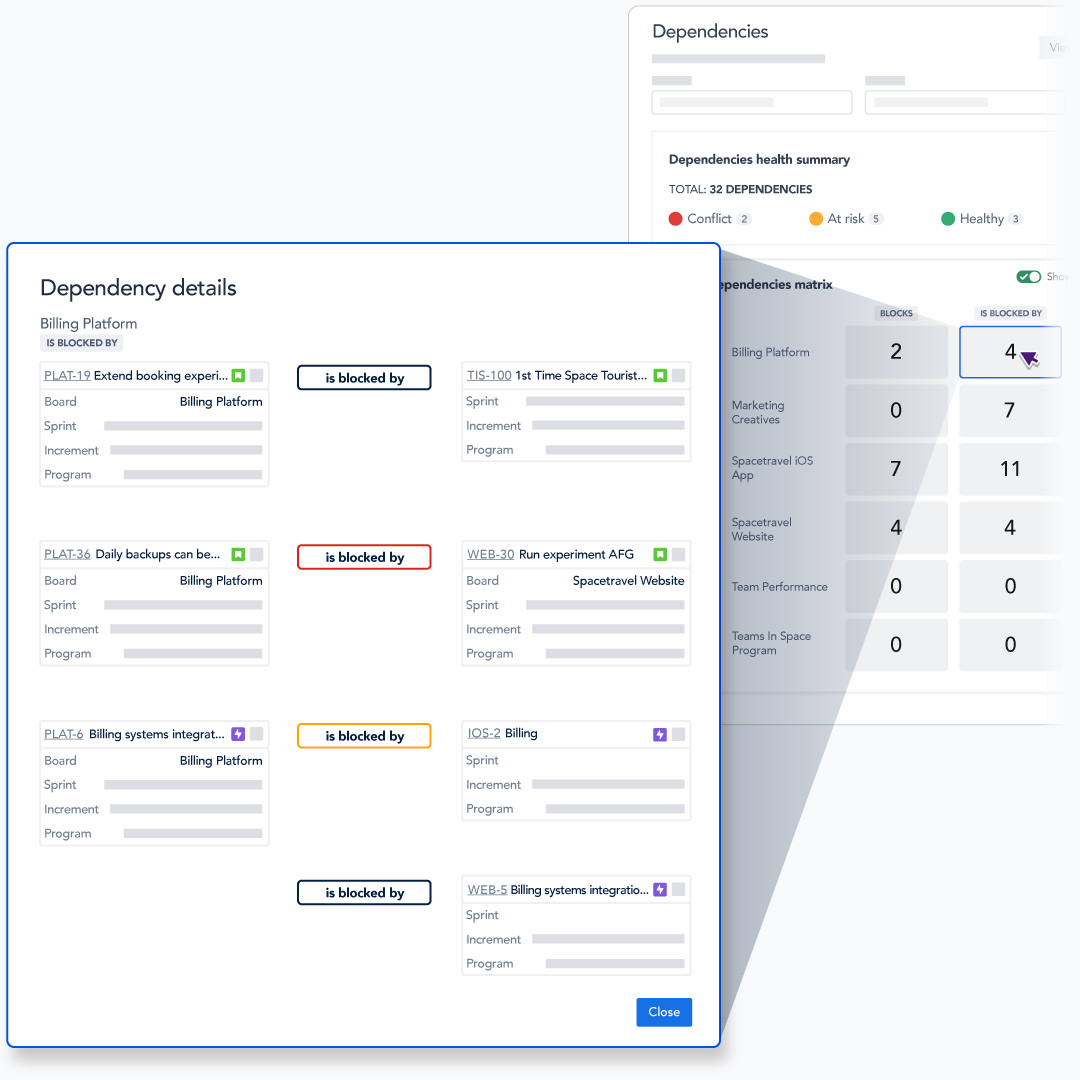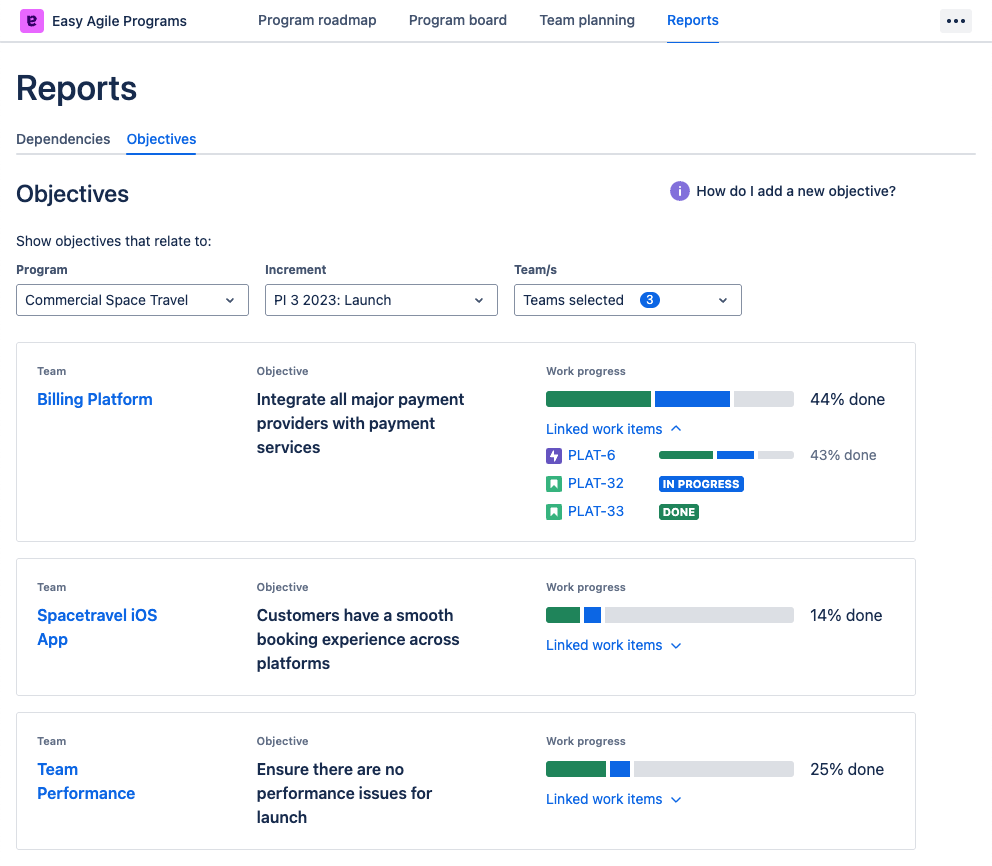We Simplified Our OKRs - and Got Better Strategy, Alignment, and Execution

TL;DR
- Simplified OKRs to two levels for clarity and focus.
- Introduced monthly confidence scoring to catch issues early.
- Strengthened cross-team collaboration and ownership.
- Replaced rigid planning with flexible roadmaps.
- How Easy Agile Programs helps teams align daily work with strategic goals.
- FAQs to help you improve your own OKR process.
At Easy Agile, we’ve spent a lot of time thinking about how to structure, align, and apply Objectives and Key Results (OKRs) in a way that actually works.
When we first introduced OKRs, our goal was to bring more strategic clarity and better alignment. But as our company grew, so did the complexity. Teams found themselves trying to work through vague objectives, siloed collaboration, and a rigid process that made it hard to adapt quickly when things changed.
Over time, through reflection and continuous feedback, we realised that great OKRs don’t just need to be clear. They also need a process that’s flexible and practical enough to help teams focus and deliver in real time.
If your organisation is running into similar issues, our journey might help you find a better path to strategy alignment.
Why We Had to Rethink Our OKRs
Our original OKR setup had company, function, and team-level objectives. While this seemed like a thorough structure, it ended up creating more complexity than clarity.
Many teams told us they felt overwhelmed by how many objectives they had to manage. Often, these objectives didn’t feel clearly tied to the overall direction of the company, which made it hard to prioritise or stay motivated.
Collaboration between teams also suffered. Important dependencies weren’t always spotted early, which led to mid-quarter issues and a lot of reactive work. On top of that, our quarterly planning cycle was too rigid. It didn’t give us enough room to pause, learn from what was happening, or shift priorities when something changed.
One of the biggest challenges was the way we tracked progress. Without a shared approach to scoring, it was hard to tell how things were really going. Teams weren’t always sure whether they were on track or falling behind, and by the time we found out, it was often too late to course correct.
From our feedback sessions, we heard some consistent problems:
- OKRs became a checkbox activity. Teams felt like they had to create objectives every quarter, but didn’t see them as useful for real decision-making.
- High-level company OKRs felt too abstract. It wasn’t clear how day-to-day work connected to broader goals.
- Cross-team collaboration was difficult. Dependencies surfaced late, which made it harder to stay aligned and meet deadlines.
- The planning cadence was too inflexible. We weren’t creating space for reflection or change during the quarter.
- Scoring was inconsistent. With no shared method for reviewing progress, we often missed early signs that something wasn’t working.
All of this made it clear: we didn’t need to adjust our OKRs; we needed to completely rethink them.
Our New OKR System: Before and After
Rather than making small tweaks, we decided to completely redesign our OKR framework. We simplified it and built in more flexibility. We wanted fewer OKRs, better collaboration, and a stronger link between strategy and delivery.
Here’s a snapshot of what changed:

Core Principles Guiding Our New Framework
This wasn’t just a structural update. It was a mindset shift. We redefined the role OKRs should play in our company and focused on what our teams actually need to do their best work: alignment, focus, and the ability to learn and adapt.
Value Over Volume
We aim for fewer, more meaningful objectives. This helps teams stay focused on what really matters without feeling overwhelmed.
Strategic Alignment
Every objective now connects clearly to a company priority. This makes it easier for teams to see how their work contributes to broader goals.
Cross-Functional Collaboration
OKRs are designed to be shared across teams. We make sure that responsibilities and dependencies are visible and co-owned.
Learning and Adaptability
We use regular check-ins, not just end-of-quarter reviews, to reflect on what’s working, spot risks, and adjust as we go.
Scoring OKRs: A More Consistent Rhythm for Progress Tracking
To improve how we track progress, we introduced a unified 1–5 confidence scoring system across the company.
Every month, teams rate their confidence in each Key Result - not just whether it’s complete, but whether we’re on track to achieve the intended outcome by the end of the quarter.
Here’s how it works:

This shared model has helped create a common language for progress, better conversations in our check-ins about what’s really happening, and proactive course corrections.
Early Wins and What’s Next
We knew this shift would take time. But even in the early stages, we’re seeing positive changes across the business. These aren’t just surface-level changes; they’re shifts in how teams think about impact, alignment, and shared responsibility.
Here’s what has stood out so far:
- Stronger strategic clarity. Teams now see how their work links to broader goals. This clarity has unlocked better prioritisation and stronger engagement.
- Improved cross-functional planning. We’re catching dependencies earlier, which means fewer mid-quarter surprises and more consistent momentum across shared initiatives.
- More meaningful check-ins. Our monthly reviews are no longer just updates. They’re real opportunities to reflect, course-correct, and celebrate progress - especially when confidence scores trend upward.
Of course, we’re not done yet. The next iteration will focus on simplifying how dependencies are captured, giving teams better support in shaping roadmaps, and reinforcing consistent practices around scoring.
How Easy Agile Programs Can Help Teams Operationalise OKRs
Once we have a clearer OKR structure, we need the right tools to support it. Easy Agile Programs helps teams turn strategy into execution that keeps OKRs visible, flexible, and connected to delivery.
Visual Goal Alignment
Easy Agile Programs makes it easy to connect team roadmaps to strategic OKRs. This helps everyone understand how their work supports the big picture - without needing to cross-reference multiple tools.

Better Collaboration and Transparency
With the Dependency Report in Easy Agile Programs, teams can visualise how their work intersects with others’ across the organisation. This early visibility helps surface potential blockers and makes it easier to coordinate shared timelines before risks turn into issues.

Strategic Prioritisation
The Objectives Report gives teams a real-time view of which objectives are in play, who’s contributing, and how much progress has been made. It helps teams stay focused on outcomes, not just activity - making it easier to course correct or re-align when needed.

OKRs Are Only as Strong as the System Behind Them
We don’t believe in one-size-fits-all frameworks. What we’ve built is a system that works for our size, our rhythm, and our teams.
It’s not about having perfect OKRs. It’s about having the right environment around them - a rhythm of planning and reflection, a shared language of progress, and clear alignment between strategy and delivery.
And getting that environment right means using tools that could support the way we actually work.
Easy Agile Programs can help with that. It gives teams the structure and visibility to turn strategic goals into coordinated execution. It helps bring teams into the planning process earlier, surface risks sooner, and keep OKRs connected to real work throughout the quarter - not just at the start and end.
OKRs don’t live in documents. They live in decisions and in the day-to-day choices teams make about where to focus. Having a tool that keeps those choices visible, flexible, and aligned will make a real difference.
We’re still learning and refining. But this shift has already helped us work with more clarity, more collaboration, and more confidence in where we’re heading.
If you’re running into similar challenges with your OKRs, we’ve been there. We’d love to share more about what’s worked for us - and hear how others are building systems that turn goals into real progress.
FAQs: Implementing Effective OKRs
How does Easy Agile establish cross-functional OKRs?
The Leadership Team drafts initial cross-functional OKRs aligned to strategic priorities, actively incorporating detailed input from teams to ensure practicality and alignment.
Do teams maintain autonomy within this OKR framework?
Yes, teams have full autonomy in determining how they operationalise OKRs through their individual roadmaps, balancing clear strategic direction with operational flexibility.
How do teams understand their contributions to OKRs?
Easy Agile Programs explicitly highlights collaborating teams and relevant initiatives, providing clarity on responsibilities and proactively managing dependencies.
What does ownership of a cross-functional OKR entail?
Ownership involves strategic coordination, proactive communication, risk management, and progress tracking—not necessarily performing every task directly.
How are routine operational tasks managed?
Operational tasks (“Keep The Lights On” activities) are tracked separately within team roadmaps, ensuring clear strategic focus without operational disruption.
How does Easy Agile handle off-track OKRs?
Our simplified 1-5 scoring system proactively identifies risks, enabling teams to quickly intervene and make agile adjustments.
Related Articles
- Agile Best Practice
Why Collaboration Gets Harder as Teams Scale
Collaboration in large-scale organisations often reveals friction in places teams expect to run smoothly. As product and development functions scale, the number of moving parts increases. So does the risk of misalignment.
At Easy Agile, conversations with our customers frequently surface familiar challenges. While each organisation is unique, the core struggles of collaboration are shared. To protect the privacy of the teams we spoke to, we’ve anonymised all quotes. But every insight is real, direct from the people doing the work.
This post is for anyone navigating the complexity of scaled collaboration, whether you're leading a team or working within one. Sometimes the hardest part is seeing the problem clearly. These are the patterns teams are running into, the questions they’re wrestling with, and the cracks that emerge when planning, alignment, and communication break down. Understanding and acknowledging these issues is the first step toward solving them.
Here’s what teams are experiencing and the key questions they’re grappling with as they scale collaboration.
TL;DR – Common collaboration challenges in scale-ups and enterprises:
- Teams struggle with communication and alignment, especially when working across multiple teams or departments
- Managing cross-team dependencies is a significant challenge, often causing delays and requiring frequent coordination
- Capacity planning and skill allocation are difficult, particularly when teams have to balance project work with ongoing operational tasks
- Teams face challenges in breaking down work effectively and maintaining visibility of progress across different teams
- Frequent changes in priorities and scope creep disrupt team planning and execution
- There are difficulties in translating high-level strategy into actionable team priorities and objectives
- Teams struggle with effective retrospectives and continuous improvement processes
What breaks down in cross-team communication?
Communication challenges tend to intensify with scale. As soon as multiple teams are involved, misalignment becomes more likely. A Senior Product Manager from a global HR tech firm described a pattern many teams will recognise:
"One of the main themes I heard in conversations with leadership was the lack of process, transparency, visibility, and dependency tracking. It’s always been manual across teams. We’ve done a really good job, but there’s an opportunity to do better."
Another team member highlighted how this disconnect tends to grow over time:
"At the start of each quarter, our conversations are strategic and cross-functional, involving sales and strategy teams. But as we dive deeper into execution, communication shrinks down to daily engineering huddles, and essential alignment details often get lost."
The problem isn't a lack of communication, but rather a shift in its focus. When delivery takes centre stage, strategic context gets sidelined. When teams move into execution mode, that shift in communication cadence creates blind spots across departments, leading to confusion, duplicated work, or misaligned outputs.
Why is managing dependencies across teams so difficult?
Dependencies create friction when they aren’t visible or clearly owned. Coordination across teams can be derailed by unclear sequencing, late handovers, or competing timelines. An Agile Coach at a financial institution shared:
"We had to run bi-weekly cross-program dependency calls just to stay on top of what was blocking who. We just list dependencies manually, there isn’t any unified visibility. At the ART level, it’s a mix of RTEs, Scrum Masters, and team members trying to link things, but beyond that, it falls apart"
A delivery leader at a global credit bureau reinforced the limitations of existing tools:
"I’ve never successfully been able to really tackle dependency visualization and put a process around that. It's always been manual. When I'm speaking to an executive, that means something... But when I'm speaking to someone on an agile team, it changes as it rolls up...Without proper plugins, even a robust tool like Jira struggles to provide clear dependency visuals. Planning becomes complicated quickly, leaving teams stuck."
Dependency risk increases when shared work isn’t tracked or visualised in a way that’s accessible to all stakeholders. Teams need to see not just their own work, but how it connects with others. Teams need more than awareness - they need shared visibility, clarity on ownership, and consistent ways to plan around dependencies.
How do teams manage capacity when demands keep shifting?
Planning team capacity isn’t just about headcount, but also about competing demands. Teams are often asked to deliver roadmap initiatives while supporting legacy systems, resolving production issues, or addressing technical debt. A product leader from a cybersecurity company shared:
"We’re always trying to achieve a lot with limited resources, and it makes roadmapping really difficult. We’ve made progress in estimating the team's bandwidth more accurately by looking at what they actually delivered last quarter. But we still hit the same issue - too many topics, too little time."
Another team shared how they introduced tighter prioritisation controls using a third-party tool, but even rigid structures have their limits:
"We use XXX as a source of truth for prioritisation. We have around 80 different initiatives prioritised from 1 to 80 of importance... no meeting can be scheduled if the project is not approved in the tool."
This helped formalise approvals and reduce noise, but it also revealed a deeper issue. Even with a strict gating process, the volume of initiatives stayed high, and prioritisation alone couldn’t solve for limited capacity. Clearer structures don’t automatically reduce the demand on teams or ease delivery expectations. That tension persists unless strategic scope is also narrowed.
What makes work breakdown and visibility so hard to maintain?
Breaking down initiatives into independent, testable stories is not always straightforward, especially when scope is uncertain or spans months. A software engineer working across multiple teams explained:
"Breaking work down is hard - some teams still think in layers. They say, ‘This only delivers value when the whole thing’s done.’ On top of that, we often run big planning in a five-hour day or stretch it awkwardly over two days. Third parties and shared services don’t get folded into teams, which makes breakdown and clarity harder."
Large epics often outlive the context in which they were created. As scope evolves, teams may struggle to maintain clear acceptance criteria and shared understanding.
An Agile Coach reinforced how hard it is to keep sight of progress:
"We break each story into smaller pieces as much as possible where it's testable by itself so the testing team can test it... But if it’s a lengthy project, spanning more than two months, it’s easy to lose clarity and effectiveness...Consistently tracking actions across multiple sprints involves endless toggling. It's difficult to quickly understand what's truly improving and what’s still stuck."
As work grows more complex, clarity suffers. Without reliable visibility, work risks stalling or repeating unnecessarily. Teams need tools, systems, and shared language to ensure breakdowns don’t get lost in the shuffle and progress remains meaningful.
Why do changing priorities and scope creep derail plans?
Frequent priority changes and scope creep disrupt planning discipline. They often signal deeper issues: vague goals, shifting leadership expectations, or unclear ownership. One product leader summed it up:
"Priorities used to switch constantly - sometimes halfway through a project, we’d have 30% done and then get pulled into something else. That context-switching really hurts. It demoralises engineers who were already deep into a feature. We had to raise it in a full engineering and product retrospective just to get some stability."
Another shared the toll it takes on delivery teams:
"We often found ourselves mid-quarter pivoting to newly emerging business needs, without fully aligning on what gets dropped. That lack of clarity meant engineers felt whiplash, and team goals kept shifting."
Without stable anchors in the form of clear goals and boundaries, even well-planned work can unravel. Work, then, expands to fill the available sprint, regardless of long-term impact, which brings us to the next challenge.
What stops teams from aligning strategy to daily work?
Teams need clear goals. But clarity breaks down when strategic objectives are too broad or when every team interprets them differently. A senior product manager explained:
"Prioritisation is only as good as your strategy, and ours wasn’t clear. The business goal was just ‘grow revenue,’ but what does that mean? Acquisition? Retention? Everyone wrote their own product objectives. It became a bit of a free-for-all. When goals are vague, it’s hard to prioritise work that ladders up to anything concrete."
Another added:
"We all set objectives tied to broad company goals, but when those goals lack precision, our objectives become misaligned, making prioritisation difficult and often inconsistent."
Without alignment between leadership priorities and team-level execution, valuable work can feel directionless. Objectives become outputs rather than outcomes.
What holds back meaningful retrospectives?
Retrospectives are intended to surface learning. But without consistent follow-through, they risk becoming routine. One Agile Coach shared how to keep them practical:
"We’ve tried tools where you just send a link and everyone rates how hard it was to get something done. But too often, it ends up with one person speaking and everyone else just agreeing. We’re trying to avoid the loudest voice dominating the retro. It’s still a challenge to get real, reflective conversations."
Another shared the risk of retro fatigue:
"To track action items consistently isn't easy... I have to toggle down and look at each one, which can make things cumbersome when ensuring certain behaviours have stuck...Effective retrospectives should surface recurring issues, not just review the recent past. Discussing ongoing challenges helps teams proactively tackle problems and move forward."
The barrier is rarely the ceremony - it’s the follow-up. Teams need lightweight ways to track retro actions, validate changes, and revisit unresolved pain points.
Where to focus
Improving collaboration means addressing the systems and habits that hold teams back:
- Keep strategic conversations active, not just at quarterly planning.
- Visualise and track cross-team dependencies clearly.
- Protect capacity for both roadmap work and operational stability.
- Break work into testable, clearly defined pieces.
- Reinforce the connection between business goals and delivery priorities.
- Make retrospective actions visible and measurable.
The teams we speak to aren’t struggling because they lack process. They’re navigating complexity. The opportunity lies in simplifying where it matters and supporting teams with the clarity to make progress, together.
The first step is recognising these patterns and giving them language. When teams can see and name the problem, they’re already on the path to solving it.
How Easy Agile can help
Whether you're dealing with blurred dependencies, vague objectives or sprint volatility, Easy Agile offers three purpose-built solutions to help teams stay aligned:
- Easy Agile Programs brings structure and visibility to cross-team planning in Jira. Perfect for managing dependencies and long-range planning across multiple teams and projects.
- Easy Agile Roadmaps gives every team a simple, shared timeline view, so they can prioritise and sequence work with strategic context.
- Easy Agile TeamRhythm makes sprint planning, story mapping, and retrospectives more engaging and purposeful, turning agile ceremonies into actionable, team-owned progress.
- Workflow
How to Make the Most of Your Sprint Goals
The sprint goal is a key aspect of any sprint, and it should be front and center throughout your two-week process. The goal ensures the team is aligned on a clear purpose for the sprint, and, if done well, the goal inspires the team to stay on track throughout the entirety of the sprint.
So, what makes a good sprint goal, and how does the sprint goal fit within the framework of a sprint? In this post, we’re going to race (or should we say sprint 😉 ) through a recap of the Scrum process, followed by a list of five critical elements of an effective sprint goal. You’ll learn how to best create, manage, and follow through on your sprint goals for a successful sprint every two weeks.
An overview of the Scrum process
We’re big fans of Scrum! Need a little refresher? Here’s how the Scrum process works and where the sprint goal fits into the whole picture.
Scrum is an agile framework used primarily by software development teams that provides team members with a streamlined workflow to meet stakeholder and customer needs. The Scrum workflow has four meetings (also known as ceremonies), which all have a distinct purpose. This structure means team members can easily support each other by sharing, tracking, and enhancing deliverables.
The Scrum framework divides work into repeating two-week sprints where a set amount of work — the sprint goal — is completed. Each Scrum begins with a sprint planning meeting, and during this time, the product owner defines the sprint goal. They choose which tasks will move from the product backlog to the sprint backlog to be completed over the following two-week sprint.
Product backlog items represent the whole picture of what needs to be accomplished before completing or releasing a product. Sprint backlog items are what the team will (hopefully) accomplish over the course of the sprint.
The Scrum Master acts as a Scrum guide who leads the team through the meetings and steps of the Scrum process. Throughout the sprint, the Scrum team meets for a daily Scrum to check in with one another and report on what work was completed over the previous 24 hours.
At the end of the sprint, a sprint review and sprint retrospective help the team gather feedback from stakeholders and improve upon their processes before the next sprint begins. The entire process repeats again with sprint planning and continues to repeat until the product or project is complete.
Easy Sprint Planning:
Drag items directly from your backlog onto your TeamRhythm User Story Map. Inline edit story summaries and story point estimates. Display your sprint goal on each sprint swimlane.
What makes a good sprint goal?
The sprint goal keeps the team focused and aligned on what everyone is trying to accomplish for each sprint. It’s an extension of the overall product or project goals, but the sprint goal can zero in on key components the team wants to tackle for that specific sprint.
What makes a good sprint goal? Let’s find out.
1. The goal is achievable
The objective of the sprint needs to be achievable within the sprint’s allotted time frame. Generally, in a Scrum framework, the team is time-bound to two weeks.
As new information is gained and other impediments occur, there’s always a chance the sprint goal won’t be met. But that shouldn’t stop you from setting achievable goals. When a team continually fails to meet the goals of the sprint and the project, morale and enthusiasm will decline.
It’s crucial that sprint goals are manageable within the allotted time of the sprint. Sprint goals can become too large when a team tries to accomplish too many different components at once or if too much of the product backlog makes it into the sprint backlog. Rather, take a reasonably achievable workload out of the product backlog to form the sprint backlog. Otherwise, you’ll end up with one daunting overall list and no clear direction for each sprint.
2. The team understands the definition of done
The clearer the sprint goal, the better. You need to clearly define the goals of the sprint and what it means to be done. How will the team know if they achieved the desired outcomes? What does “done” look like? Does everyone agree on this definition for every given task and the overall goals of the sprint?
Your goals need to be measurable to limit ambiguity, subjectivity, or conflicting opinions around the success of the sprint.
When a team is aligned, and everyone understands what needs to be accomplished, decision-making improves, and each aspect of the Scrum team can work harmoniously toward the same aims.
3. The sprint goal is meaningful to the team
Beyond knowing what the team hopes to accomplish over the course of each sprint, the team needs to understand the reasoning behind the sprint goal.
Make sure everyone understands why they are working towards a specific sprint goal. What meaning does the sprint goal have? Ideally, the meaning of the sprint goal will relate back to stakeholder needs, the customer journey, or the user experience of your product.
Visualize and prioritize the work that will deliver the most value to your customers
Easy Agile TeamRhythm
4. The sprint goal aligns with the overall product goals
The sprint goal can zero in on a specific aspect of product development, but it should still connect to the overall product goals.
While creating sprint goals, ensure the overarching product vision isn’t lost or ignored. Every sprint, while specific to its own set of goals, should work toward accomplishing your product goals.
5. The sprint goal is visible throughout the sprint
The sprint goal can’t be a “set it and forget it” aspect of your sprint. It should be visible to the team the entire time, and the team needs to continually check in on the goal to ensure they’re on track to achieve it.
The shared goal should be front and center of daily Scrum meetings. If possible, display the sprint goal for everyone to see. As you accomplish backlog items and work through the sprint, continually reference the sprint goal and the progress you are making toward it. How likely are you to achieve the sprint goal considering the time you have remaining in the sprint? What might be standing in the way of achieving this goal?
During the sprint retrospective, you should discuss the success or lack of success the team made on the sprint goal. What went well and contributed to your success? What didn’t go so well that you could change or do differently for the next sprint?
With Easy Agile TeamRhythm, each scrum board in Jira will have an associated User Story Map.
Throughout the sprint, the team can refer to the User Story Map to make sure they’re on schedule, coordinate dependencies, and keep sight of the big picture.A customer-centric approach
Let’s recap a few of the most important factors to remember when establishing and following through on your sprint goal:
✅ Ensure the goal is achievable.
✅ Ensure the team understands the definition of done.
✅ Ensure the sprint goal is meaningful for the team.
✅ Ensure the sprint goal aligns with the overall product goals.
✅ Ensure the sprint goal is visible throughout the sprint.
Thanks for sticking with us and utilizing the Easy Agile blog. We’re passionate about helping teams work better with agile. We have a suite of Jira apps designed to keep the customer top-of-mind through every step of the development process.
Looking for a tool to streamline your sprint planning sessions? Check out Easy Agile TeamRhythm, which transforms the flat product backlog into a meaningful picture of work.
- Agile Best Practice
How to Create a Team Charter: Template and Guide for Engineering and Product Teams
High-performing teams don't happen by accident. They're built through intentional conversations about how to work together effectively.
Creating alignment isn't about one-off workshops. It's about clarity that sticks. A team charter gives agile teams the shared understanding they need to work better together, especially as teams grow, change, and evolve how they work. Without one, ambiguity creeps in, especially in remote or distributed environments where body language and hallway conversations aren't an option.
TL;DR
- A team charter is a shared agreement that defines how a team works together.
- It helps build trust, align expectations, and reduce friction.
- Creating one involves four stages: define purpose, agree on behaviours, map workflows, and embed the document.
- It evolves with the team and supports onboarding, retros, and continuous improvement.
What is a Team Charter?
A team charter is a living document co-created by the team. It outlines the team's shared understanding around purpose, values, responsibilities, and ways of working. It sets the tone for how people communicate, collaborate, and make decisions.
Think of it as a blueprint for a high-performing team: aspirational, but grounded in the daily realities of team life, and aligned with agile ceremonies like stand-ups, sprint reviews, and retrospectives that reinforce shared understanding. It reduces duplication, limits confusion, and gives structure to how we operate - even when the unexpected shows up.
Benefits of a Team Charter for Agile Teams
At its core, a team charter addresses the fundamental questions that cause most team dysfunction:
- What is our purpose as a team? Why do we exist?
- What is within the scope of our team?
- What outcomes are we accountable for?
- How do we treat each other as team members?
- How do we make decisions and communicate?
- What are our individual roles and responsibilities?
- How do we celebrate success?
What a Well-Crafted Team Charter Can Unlock
1. Clarity and Alignment
A team charter serves as a clear roadmap that defines the team's mission, goals, roles, and responsibilities. It ensures everyone understands how their work contributes to team success.
2. Better Decision-Making
When responsibilities and communication protocols are clear, decisions are made faster and more consistently.
3. Improved Communication
Establishing communication norms upfront ensures smoother knowledge sharing and transparency.
4. Accountability and Ownership
Team members know what they're responsible for, fostering commitment and initiative.
5. Trust and Team Cohesion
The collaborative process of creating a charter builds trust and empathy, and strengthens team dynamics.
6. Continuous Improvement
Team charters encourage feedback and reflection, evolving with your team over time.
7. Streamlined Onboarding
Team charter serves as a vital guide for new team members, offering clear insight into the team's norms, values, and workflows, accelerating their integration and boosting early productivity.
8. Living Reference Document
The charter acts as a reference tool that keeps everyone grounded and aligned as the team changes.
Four Practical Steps to Build a Team Charter
The team charter process is typically split into four interactive sessions. Each phase builds on the last and creates the trust, clarity, and psychological safety needed for the next.
Phase 1: Define Purpose and People
The team's mission refers to the objective or goal that a team is set to achieve. It is a clear and concise statement that defines the team's purpose and the value it aims to deliver.
Start by co-creating the team's mission statement. Team members contribute by answering: "What value do we deliver? What impact do we want to have?"
Everyone shares their input, then the team votes on the mission statements that resonate most. You can even combine parts from several to create the final version.
Once established, the mission should be displayed publicly where everyone can see it and team members can reference it.

Then we go deeper, with Personal Operating Instructions (POIs). This phase focuses on understanding team members as individuals. Each person answers questions like:
- What do you love about your job?
- What motivates you?
- How do you like to work?
- When do you work best?
- What do you want help to look like?
This helps us build empathy and challenge assumptions. It makes team members understand behaviours and uncover ways to support one another.

Phase 2: Create a Working Agreement
A working agreement is a team-designed agreement for an aspirational set of values, behaviours and social norms. Think of it as a vision for how it would be to work in an incredibly safe and powerful team.
This is where the real power lies, where you get specific about operations. Through a mix of guided reflection and group synthesis, the team explores questions like:
- What makes a great team vs. a terrible team?
- How do we communicate?
- How do we make decisions?
- What are our top responsibilities?
- What are our daily rhythms (e.g., stand-ups, reviews)?

And don’t stop at logistics, go deeper:
- How do we give feedback?
- What do we do when someone’s stuck?
- How do we balance collaboration and deep work?
- How do we share knowledge?
- How do we run meetings?
- How do we support remote or hybrid work?
- How do we protect focus time?
- How do we resolve disagreements?


From this, draft short, memorable working agreement statements. For example: "We default to asynchronous communication whenever possible," or "We commit to reviewing pull requests within 24 hours." Themes like "Diverse opinions welcome" or "Refactoring is a first-class citizen" should emerge.
💡 Tip: If your team uses Easy Agile TeamRhythm, you can incorporate these agreements into planning and retro directly.
Here are two examples of working agreements:

Image Source 
Image Source Phase 3: Map an Operational Agreement
Next, turn principles into rituals. Visualise your delivery flow using tools like Kanban boards, swimlanes, or service blueprints, whatever format helps your team see the full picture clearly:
- Who leads each stage?
- What’s working?
- What’s broken?
- What needs to be true for work to move forward?
Capture frictions around unclear ownership or ambiguous definitions. This surfaces hidden blockers and leads to better alignment.
💡 Tip: Consider using a collaborative tool like Miro, Easy Agile Programs, or whiteboarding sessions to map your current process together.


Phase 4: Make It Stick
A charter only works if it lives in your team’s daily rhythm. Otherwise, it risks becoming 'shelfware' that gets created once and forgotten. Keep it active, visible, and revisited to maintain its impact.
- Share and communicate: Make it accessible and visible.
- Live by the charter: Role model the behaviours you agreed on.
- Review and update regularly: Revisit and evolve it as your team changes.
- Use as a reference: Ground retrospectives and decisions in it.
- Reflect often: Use it to discuss what’s working and what’s not.
💡 Tip: Add your charter as a living page in your team workspace (like Confluence) and link to it in your planning tools.
Onboarding New Team Members with a Charter
When someone new joins the team, it's time to review the charter. Here’s a step-by-step onboarding process:
- Initial walkthrough: A team lead introduces the charter and context.
- Time to absorb: The new member reads and reflects.
- Team review: The team invites their feedback and updates the charter together.
This creates buy-in and strengthens psychological safety.
💡 Tip: Schedule a 30-minute team check-in with each new hire after their first two weeks to revisit the charter together.
The Foundation of High Performance
A team charter isn’t just a document. It’s a shared commitment to how you work together. It evolves as your team does, helping you navigate change and stay aligned.
If there’s one thing we’ve learned, it’s that culture isn’t declared. It’s designed, together.
Whether forming a new team or elevating an existing one, your charter is a powerful first step toward intentional, aligned collaboration.
Suggested Next Step
If you're looking to embed your team charter into your team's everyday rhythm, Easy Agile apps like TeamRhythm and Programs help teams turn working agreements into action by aligning daily rituals such as sprint planning, stand-ups, retrospectives, and PI planning.



